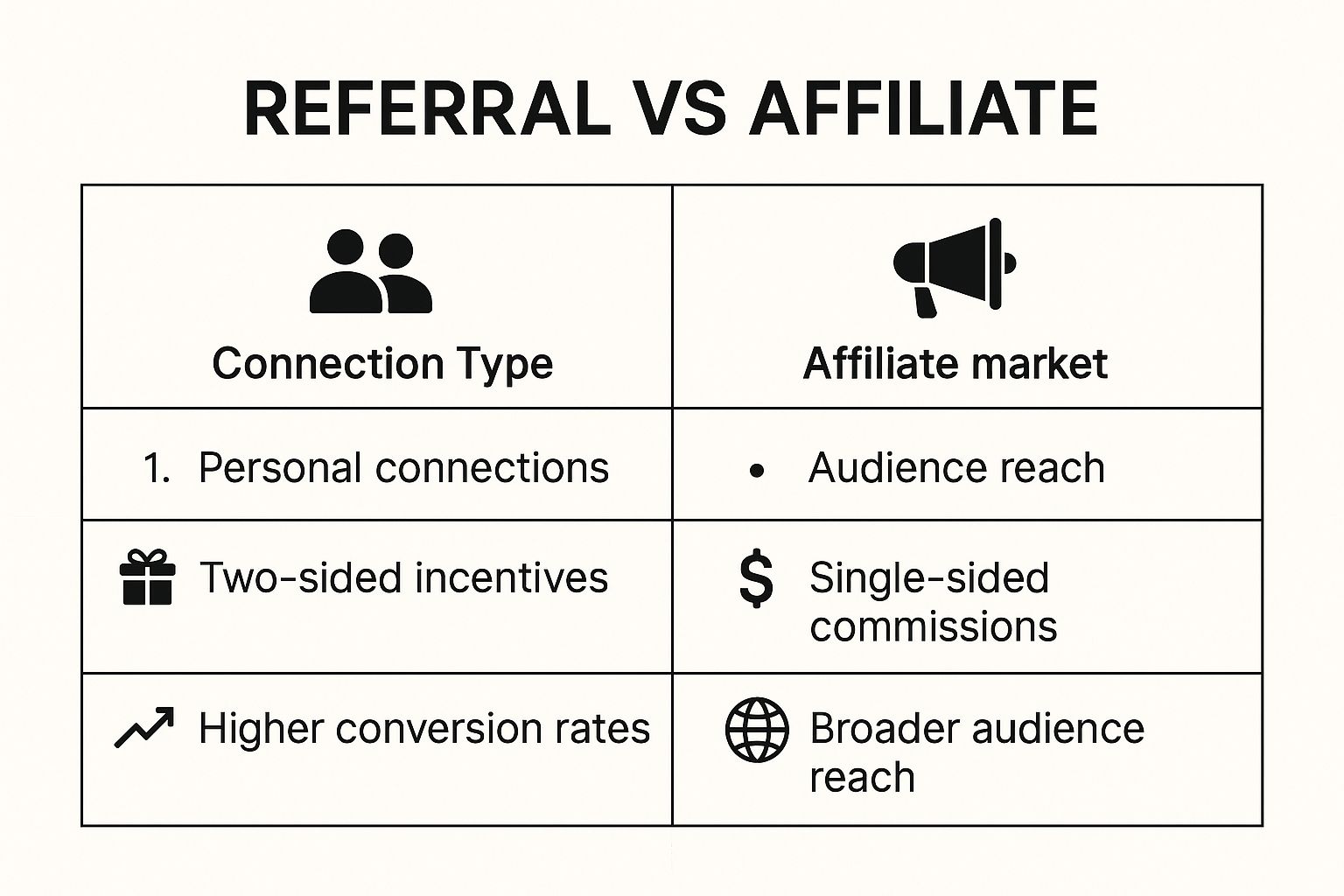Understanding the Power of Referral and Affiliate Programs
Want to boost customer acquisition? This listicle clarifies 7 key differences between referral marketing vs affiliate marketing to help you choose the right strategy. We'll cover everything from compensation and technology to compliance and growth potential, so you can decide whether referrals, affiliates, or a combination of both best suits your startup. Understanding these differences is crucial for optimizing your marketing budget and driving sustainable growth.
1. Definition and Fundamental Differences
Understanding the core distinctions between referral marketing and affiliate marketing is crucial for leveraging the right strategy for your business. Both are powerful methods for driving growth through third-party advocates, but they operate on different principles and cater to different scenarios. Referral marketing relies on the power of personal recommendations. It encourages existing, satisfied customers to recommend your product or service to their network of friends, family, and colleagues – people they know and trust. This fosters a potent word-of-mouth effect, capitalizing on pre-existing relationships. Affiliate marketing, on the other hand, leverages the reach of third-party promoters, often content creators, bloggers, or influencers, who market your product to their audience in exchange for a commission. These affiliates don't necessarily have a personal relationship with your brand or product, but they connect you with a wider audience segment.

The infographic above provides a quick reference summarizing the key differences between referral and affiliate marketing. As you can see, referrals thrive on personal connections and trust, resulting in higher conversion rates, while affiliate marketing casts a wider net, reaching larger audiences through diverse channels. This difference in approach impacts the structure of the reward systems as well; referral programs usually reward both the referrer and the referred new customer (double-sided incentive), while affiliate programs typically only reward the affiliate for driving a sale or lead.
For early-stage startups, self-serve SaaS companies, product-led growth SaaS, SaaS founders, and indie hackers, understanding these nuances is particularly important. Choosing the right approach can significantly impact your customer acquisition cost and overall growth trajectory. For example, a SaaS company with a strong product and a growing user base might find referral marketing a cost-effective way to fuel organic growth.
Here are some key takeaways about the core differences:
- Referral Marketing: Leverages personal connections, rewards both referrer and referee, higher conversion rates, slower scaling.
- Affiliate Marketing: Leverages audience reach, rewards only the affiliate, lower conversion rates (generally), faster scaling.
Learn more about Definition and Fundamental Differences
Examples of Successful Implementation:
- Referral: Dropbox's 'Give 2GB, Get 2GB' program incentivized existing users to invite their friends, leading to significant user growth.
- Affiliate: Amazon Associates program empowers website owners and bloggers to earn commissions by recommending Amazon products.
Actionable Tips:
- For Referrals: Design a program that’s easy to understand and participate in. Offer compelling rewards that benefit both parties.
- For Affiliates: Identify relevant influencers and content creators within your niche. Offer competitive commission structures and provide them with the resources they need to succeed.
Pros and Cons:
- Pros (Both): Scalable acquisition channels, reduced upfront marketing costs (pay-for-performance), leveraged third-party credibility.
- Cons: Referral marketing may scale more slowly. Affiliate marketing may attract lower-quality leads. Both require robust tracking and attribution systems.
When and Why to Use Each Approach:
- Referral Marketing: Ideal when your product relies on word-of-mouth and customer satisfaction is high. Excellent for building a loyal customer base.
- Affiliate Marketing: Effective for reaching a wider audience quickly and increasing brand visibility. Particularly useful for product launches and promotions.
By understanding the fundamental differences between referral marketing and affiliate marketing, you can strategically choose the best approach—or even a combination of both—to maximize your growth potential and achieve your business objectives.
2. Compensation Models and Structures
A key differentiator between referral marketing and affiliate marketing lies in their compensation models and structures. Understanding these differences is crucial for choosing the right strategy for your business, especially for early-stage startups, SaaS founders, and indie hackers looking to maximize their marketing ROI. These programs differ significantly in terms of commission rates, payment triggers, and reward types. These differences reflect the distinct nature of the relationships and expected conversion rates in each system. Referral marketing leverages existing customer relationships, while affiliate marketing relies on external partners to promote a product or service. Therefore, the payment structures are designed to incentivize different behaviors.

Referral programs often utilize two-sided incentives, rewarding both the referrer (existing customer) and the referred friend. Rewards can range from fixed discounts, free products, or credits to percentage-based discounts on future purchases. For instance, Uber offers ride credits to both parties in their referral program, encouraging existing users to invite friends and family. This creates immediate value for the customer and fosters a sense of community. Conversely, affiliate programs typically offer one-sided commissions paid solely to the affiliate (promoter) for driving conversions. These commissions are generally percentage-based or pay-per-action (CPA). A prime example is Pat Flynn of Smart Passive Income, who earns six figures annually through affiliate commissions by recommending software and tools to his audience. ConvertKit, an email marketing platform, offers a compelling affiliate program with up to 30% recurring commission, attracting affiliates with the potential for substantial passive income.
Pros:
- Affiliate Commissions: Can create sustainable income for creators and affiliates. This incentivizes them to actively promote your product.
- Referral Rewards: Create immediate value for existing customers, fostering loyalty and encouraging word-of-mouth marketing.
- Alignment with Business Goals: Both models can be structured to align incentives with specific business goals, such as customer acquisition or increased sales.
Cons:
- Higher Affiliate Commissions: Can significantly increase customer acquisition costs, especially for competitive niches.
- Two-Sided Referral Rewards: Can be more expensive to maintain compared to one-sided affiliate commissions.
- Complex Commission Structures: Tiered programs and varying commission rates can be difficult to track and calculate accurately.
Tips for Successful Implementation:
- Testing: Test different reward structures and commission rates to determine the optimal conversion rates for your target audience. A/B testing can help fine-tune your program.
- Lifetime Value (LTV): Consider the lifetime value of a customer when setting commission rates. Higher LTV justifies potentially higher commissions.
- Tracking Cookies: Implement tracking cookies with an appropriate duration (typically 30-90 days) to accurately attribute conversions to the correct affiliate or referrer.
This aspect of referral marketing vs. affiliate marketing is critical because it directly impacts your budget and the overall success of your program. Choosing the correct compensation model hinges on understanding your target audience, the nature of your product or service (especially for SaaS companies with recurring revenue), and your overall marketing objectives. By carefully considering the pros and cons of each structure, you can create a program that effectively incentivizes desired behaviors and drives sustainable growth.
3. Technology and Implementation Platforms
A critical aspect of comparing referral marketing vs affiliate marketing lies in understanding the technological infrastructure needed for each. Both strategies require distinct approaches to tracking, integration, and overall program management. This difference significantly influences the complexity and cost of implementing each program. While both aim to drive growth through third-party promotions, the technical execution varies considerably. Referral programs often focus on existing customer relationships and leverage social sharing, while affiliate programs cast a wider net, partnering with various online content creators and publishers. This distinction impacts the features and capabilities required from their respective platforms.

Referral software prioritizes simplicity and social sharing functionalities, often integrating directly into a company's website or app. This streamlined approach makes it easier for existing customers to refer friends and family. Conversely, affiliate platforms demand more robust tracking capabilities to monitor conversions across various websites and affiliate links. These platforms need to accurately attribute sales to specific affiliates, manage commission payouts, and provide detailed performance analytics. Affiliate networks add another layer of complexity, acting as intermediaries between brands and a vast pool of potential affiliates. For instance, managing influencer relationships often requires dedicated platforms. Numerous platforms exist to facilitate and manage influencer marketing campaigns. These platforms offer various tools and resources for brands and influencers to connect and collaborate effectively. You can explore some of the leading options in this overview of influencer marketing platforms and marketplaces. Regardless of your chosen strategy, content management and compliance monitoring are essential for a successful affiliate program.
Pros of Using SaaS Platforms:
- Reduced Development Time: SaaS solutions drastically cut down the time and resources required to build a referral or affiliate program from scratch.
- Advanced Analytics: Modern platforms offer comprehensive analytics and optimization tools to track key metrics, understand program performance, and identify areas for improvement.
- Seamless Integration: API integrations simplify the process of connecting these platforms with existing CRM, email marketing, and other essential business systems.
Cons of Using SaaS Platforms:
- Additional Costs: Third-party platforms come with recurring subscription fees, adding to the overall marketing budget.
- Cookie Tracking Challenges: Increasing privacy regulations and the phasing out of third-party cookies pose challenges for accurate affiliate tracking and attribution.
- Integration Complexities: While API integrations make implementation easier, integrating with existing systems can still be complex and require technical expertise.
Examples of Referral and Affiliate Platforms:
- Referral Platforms: ReferralCandy, Friendbuy, Referral Factory
- Affiliate Platforms: Impact, AWIN, CJ Affiliate, ShareASale
- Integrated Platforms: Shopify offers both referral and affiliate marketing capabilities within its platform.
Tips for Choosing the Right Platform:
- Mobile Tracking: Prioritize platforms with robust mobile tracking capabilities to capture referrals and conversions from mobile devices.
- Privacy Compliance: Ensure the chosen platform complies with GDPR and other relevant privacy regulations.
- Fraud Detection: Opt for systems with robust fraud detection features to prevent abuse and maintain program integrity.
- Tech Stack Integration: Select a platform that seamlessly integrates with your existing marketing and sales technology stack.
Companies like Commission Junction (now CJ Affiliate) and Rakuten (formerly LinkShare) played a pivotal role in popularizing and standardizing affiliate marketing platforms.
Learn more about Technology and Implementation Platforms
Deciding between referral marketing vs affiliate marketing hinges on understanding your target audience, marketing goals, and available resources. For early-stage startups, SaaS companies, and product-led growth businesses, referral programs can be an effective way to leverage existing customer loyalty and drive organic growth. Affiliate marketing, on the other hand, is better suited for businesses with established brands and broader marketing reach. Carefully evaluating the technological requirements and choosing the right platform are essential for the success of either strategy.
4. Relationship Dynamics and Trust Factors
A critical differentiator between referral marketing and affiliate marketing lies in the underlying relationships and how they influence trust. This directly impacts conversion rates, the quality of acquired customers, and their long-term value. Understanding these dynamics is crucial for choosing the right strategy for your business, particularly for early-stage startups, self-serve SaaS companies, and product-led growth SaaS striving for sustainable growth.

Referral marketing thrives on pre-existing trust within personal networks. Recommendations come from friends, family, or colleagues, carrying the weight of a personal endorsement. This implicit trust stems from social capital built over time. Conversely, affiliate marketing relies on the credibility of the affiliate with their audience. While affiliates cultivate relationships with their audience, they may not have personal connections with individual prospects. Their endorsements can range from genuinely enthusiastic to purely transactional, with trust built upon domain expertise or audience rapport. This distinction is paramount when comparing referral marketing vs affiliate marketing.
Features:
- Referrals: Originate from direct personal relationships (friends, family, colleagues). Recommendations carry an implicit personal endorsement. Trust is based on social capital.
- Affiliates: Maintain audience relationships but may not know individual prospects. Endorsements can vary from genuine to transactional. Trust is based on domain expertise or audience rapport.
Pros:
- Referrals: Typically convert at 3-5x higher rates than non-referred leads. Referred customers often exhibit higher lifetime value and retention.
- Affiliates: Can reach specialized audiences through niche influencers, expanding your reach beyond existing networks.
Cons:
- Referrals: Incentivized referrals can sometimes dilute the authenticity of recommendations. Scaling referral programs can be challenging.
- Affiliates: Poor affiliate practices can negatively impact brand reputation. Affiliate relationships require ongoing management and oversight.
Examples:
- Tesla's referral program: Successfully leveraged owner enthusiasm and expertise to drive new customer acquisition.
- Wirecutter (NYT): Built trust and a loyal audience through in-depth product reviews within their affiliate content.
- Robinhood's referral program: Generated viral growth by leveraging social proof and incentivized referrals.
Tips for SaaS Founders and Indie Hackers:
- Cultivate authentic relationships with top-performing affiliates: Prioritize quality over quantity. Partner with affiliates who genuinely align with your brand values and target audience.
- Create referral messaging that respects the personal nature of recommendations: Avoid overly promotional language. Empower your users to share genuine experiences.
- Monitor affiliate content for alignment with brand values: Ensure consistent messaging and prevent any potential damage to your brand reputation.
This aspect of relationship dynamics and trust is crucial for understanding the core differences between referral marketing vs affiliate marketing. For SaaS founders, indie hackers, and product-led growth companies, recognizing these nuances allows for strategic program development and maximizing the potential of both referral and affiliate marketing strategies. Pat Flynn's popularized "serving first" affiliate marketing philosophy, and Michelle Schroeder-Gardner (Making Sense of Cents) demonstrates transparent affiliate marketing exemplify how building genuine relationships can lead to long-term success. By focusing on the right type of relationship for your target audience, you can unlock sustainable growth and build a loyal customer base.
5. Scale and Growth Potential
When comparing referral marketing vs affiliate marketing, understanding their respective scaling potential is crucial for choosing the right strategy. This factor is particularly important for early-stage startups, self-serve SaaS companies, product-led growth SaaS, SaaS founders, and indie hackers looking for sustainable and efficient growth. While both referral and affiliate marketing can fuel impressive growth, they achieve it through different mechanisms and at different paces.
How Referral and Affiliate Marketing Scale Differently:
Affiliate marketing offers a broader reach right out of the gate. By leveraging established content creators and influencers, businesses can tap into pre-built audiences and quickly generate significant traffic volume. This makes affiliate programs ideal for quickly expanding brand awareness and reaching new customer segments. However, managing a large affiliate program requires significant resources, including recruitment, relationship management, and ongoing communication.
Referral marketing, on the other hand, scales organically with your existing customer base. It relies on the power of word-of-mouth and customer advocacy to drive growth. This approach typically yields higher-quality leads and better customer retention, as referred customers come pre-vetted and are more likely to align with your brand values. The downside is that referral programs require an existing, satisfied customer base to be effective. Building that initial base requires effort and a focus on delivering exceptional customer experiences.
Features and Benefits Comparison:
| Feature | Affiliate Marketing | Referral Marketing |
|---|---|---|
| Reach | Broader, faster initial reach | Scales with customer base |
| Customer Quality | Varies depending on affiliate | Typically higher quality |
| Speed | Immediate distribution potential | Requires existing customer base |
| Scaling Requirements | Recruitment, relationship management | Customer satisfaction, engagement |
Pros and Cons:
Affiliate Marketing:
- Pros: Drives significant traffic quickly, reaches new audiences effectively.
- Cons: Requires significant management resources, quality of leads can vary, faces diminishing returns without continuous optimization.
Referral Marketing:
- Pros: Produces higher-quality leads, better customer retention, more sustainable growth.
- Cons: Depends on customer willingness to advocate, requires an existing customer base, faces diminishing returns without continuous optimization.
Examples of Successful Implementation:
- Airbnb: Their referral program fueled exponential growth by incentivizing both the referrer and the referred user with travel credits.
- Shopify: Their extensive affiliate program helped them reach millions of merchants by partnering with bloggers, educators, and industry influencers.
- PayPal: Their early referral program, offering $10 for both the referrer and the referred user upon signup, drove rapid user acquisition in their initial growth phase.
- Dropbox: Became a case study for referral-driven growth by offering extra storage space for both the referrer and the referred user.
- Amazon Associates: Pioneered large-scale affiliate marketing, allowing website owners and bloggers to earn commissions by recommending Amazon products.
Actionable Tips for Startups and SaaS Companies:
- Start with referrals: If you have high customer satisfaction but a limited marketing budget, prioritize building a strong referral program.
- Launch affiliate programs: When you need to reach new audience segments quickly or boost brand awareness, consider implementing an affiliate program.
- Create tiered incentives: Reward both volume and quality by offering different incentives based on performance.
- Develop resources and training for affiliates: Equip your affiliates with the tools and knowledge they need to create effective content and drive conversions.
When to Use Which Approach:
- Early-stage startups: Focus on building a strong foundation with referral marketing, leveraging early adopters and brand advocates.
- Product-led growth SaaS: Prioritize referral marketing to leverage the inherent virality of your product.
- Self-serve SaaS companies: Implement affiliate marketing to reach specific niche audiences and expand your market reach.
By carefully considering these factors and understanding the nuances of referral marketing vs affiliate marketing, businesses can choose the strategy best suited to their specific stage, goals, and resources. This informed decision is crucial for achieving sustainable, scalable growth.
6. Regulatory Compliance and Disclosures
When comparing referral marketing vs affiliate marketing, understanding the legal landscape is crucial. This section dives into the critical area of regulatory compliance and disclosures, a key differentiator between the two strategies. Navigating these requirements correctly is essential for building trust, avoiding penalties, and ensuring the long-term success of your marketing efforts, particularly for early-stage startups, self-serve SaaS companies, product-led growth SaaS, SaaS founders, and indie hackers.
A key distinction between referral marketing and affiliate marketing lies in the stringency of regulatory oversight. While both must adhere to general data privacy regulations like GDPR and CCPA, affiliate marketing faces significantly stricter disclosure requirements. This is because affiliate marketing involves a more explicit financial relationship between the promoter and the brand, creating a higher potential for biased endorsements.
Features and Requirements:
- Affiliate Marketing Disclosures: The FTC's endorsement guidelines mandate clear and conspicuous disclosure of any financial relationship between the affiliate and the brand. This means affiliates must explicitly state that they earn a commission for promoting the product or service. This applies across various platforms, including blogs, social media, and email marketing.
- Referral Program Disclosures: Referral programs, which typically incentivize existing customers to refer friends and family, generally face fewer disclosure requirements. However, transparency is still best practice. Clearly stating the reward structure for both the referrer and the referred friend fosters trust and avoids any perception of deception.
- Industry-Specific Regulations: Affiliate marketing in regulated industries like finance, healthcare, and gambling faces additional restrictions. These industries often have specific advertising guidelines and licensing requirements that affiliates must comply with.
- Tax Implications: The tax implications also differ. Referral rewards are often considered rebates or discounts and may not be taxable for the referrer, while affiliate income is generally considered taxable income.
Pros of Compliance:
- Increased Trust and Conversion Rates: Counterintuitively, clear disclosures can actually boost trust and conversion rates. Transparency builds credibility with consumers, making them more likely to engage with recommendations.
- Ethical Marketing Framework: Compliance frameworks provide clear guidelines for ethical marketing practices, fostering a culture of responsibility and integrity.
- Reduced Legal and Reputational Risks: Adhering to regulations mitigates the risk of legal penalties, negative publicity, and damage to brand reputation.
Cons of Compliance:
- Administrative Overhead: Implementing robust compliance procedures requires resources and effort. Tracking disclosures, managing affiliate agreements, and conducting regular audits can add to administrative overhead.
- Navigating International Regulations: Running international programs necessitates navigating a complex web of varying regulatory landscapes. Each country may have its own specific disclosure requirements.
- Penalties for Non-Compliance: The penalties for non-compliance can be substantial, ranging from hefty fines to legal action and reputational damage.
Examples:
- Amazon: Amazon has faced FTC scrutiny regarding influencer disclosure compliance, highlighting the importance of clear and consistent disclosure practices.
- Fashion Nova: Fashion Nova paid $9.3M to settle FTC charges related to suppressing negative reviews, demonstrating the serious consequences of non-compliant marketing tactics.
- Pinterest: Pinterest’s clear disclosure of affiliate links within pins contributes to maintaining user trust and demonstrates best practice.
Actionable Tips:
- Disclosure Templates: Create clear and concise disclosure templates for your affiliates to use, ensuring consistency and compliance across all promotional materials.
- Affiliate Agreements: Include specific compliance requirements within your affiliate agreements, outlining expectations and responsibilities.
- Regular Audits: Implement regular audits of affiliate content to ensure proper disclosures are being used and that promotional activities align with your brand guidelines.
- Legal Counsel: Consult with legal experts when designing programs for regulated industries to navigate specific compliance requirements.
Influence and Advocacy:
The FTC’s endorsement guidelines have significantly shaped affiliate marketing practices, setting the standard for disclosure requirements. Industry organizations like the Performance Marketing Association (PMA) also advocate for ethical standards and best practices within the affiliate marketing industry.
This area deserves its place on this list because understanding regulatory compliance is fundamental to building a sustainable and ethical marketing strategy. For startups and SaaS companies especially, avoiding legal pitfalls early on is crucial for long-term growth. By proactively addressing these considerations, you can establish trust with your audience, protect your brand reputation, and maximize the effectiveness of both your referral and affiliate marketing programs.
7. Performance Metrics and Attribution Models
Understanding the effectiveness of your marketing strategies is crucial, especially when comparing referral marketing vs affiliate marketing. This is where performance metrics and attribution models come into play. They provide the necessary insights to measure success, optimize campaigns, and ultimately, demonstrate the return on investment (ROI) for both referral and affiliate programs. This is particularly important for early-stage startups, self-serve SaaS companies, product-led growth SaaS, SaaS founders, and indie hackers who need to make every marketing dollar count.
While both referral and affiliate marketing aim to acquire new customers, the ways you track and analyze their performance differ significantly. This difference stems from the inherent nature of each approach. Referral programs often rely on personal relationships and trust, leading to a simpler, more direct tracking method. Affiliate marketing, on the other hand, frequently involves a broader network of partners and diverse promotional channels, necessitating more complex attribution models.
Features and Benefits:
- Affiliate Marketing Metrics: Typically utilizes last-click attribution, focusing on metrics like Earnings Per Click (EPC), conversion rates, and also incorporates content quality and compliance metrics. This allows for a clear understanding of which affiliates are driving the most valuable traffic and conversions.
- Referral Program Metrics: Employs simpler, often direct tracking codes and emphasizes metrics like referral rate, sharing metrics, and customer segment analysis. This allows businesses to identify their most influential advocates and understand which customer segments are most responsive to referral campaigns.
- Attribution Models: Different models, such as last-click, first-click, or multi-touch attribution, assign credit for conversions to various touchpoints in the customer journey. Choosing the right model depends on the complexity of your marketing mix and the specific goals of your program. Learn more about Performance Metrics and Attribution Models.
Pros:
- Data-Driven Optimization: Analyzing performance metrics allows for data-driven optimization, enabling you to fine-tune your campaigns for maximum impact.
- Fair Compensation: Accurate attribution ensures fair compensation for affiliates, motivating them to continue promoting your product or service.
- Channel Identification: Advanced analytics reveal the highest-value acquisition channels, allowing you to prioritize your marketing efforts effectively.
Cons:
- Attribution Complexity: Implementing multi-touch attribution can be complex, requiring sophisticated tracking and analysis tools.
- Attribution Conflicts: Conflicts can arise when multiple marketing channels contribute to a single conversion, making it difficult to assign credit accurately.
- Privacy Changes: Evolving privacy regulations and browser restrictions can impact tracking capabilities, making accurate attribution more challenging.
Examples of Successful Implementation:
- Airbnb: Their data team optimized their referral program by identifying high-value referrers and tailoring their messaging to encourage more referrals from these key individuals.
- Awin: By implementing cross-device tracking, Awin improved the accuracy of their affiliate attribution, ensuring affiliates were properly credited for conversions that spanned multiple devices.
- Honey: Their affiliate success metrics focus on both clicks and qualified purchases, ensuring they are attracting high-quality traffic that converts into paying customers.
Actionable Tips:
- Track Customer Lifetime Value (CLV): Compare the CLV of customers acquired through referrals versus affiliate marketing to understand the long-term value of each channel.
- Post-Conversion Surveys: Implement post-conversion surveys to gain insights into the customer journey and validate attribution data.
- Cohort Analysis: Use cohort analysis to measure long-term performance differences between customer groups acquired through different channels.
- Attribution Window Testing: Test different attribution windows to find the optimal setting that accurately reflects the influence of your marketing efforts.
- Qualitative Feedback: Combine quantitative metrics with qualitative feedback from customers and partners to gain a more holistic understanding of your program's performance.
Popularized By:
Industry leaders like Google Analytics have popularized attribution modeling for marketers, making it an essential tool for understanding campaign performance. Growth marketing experts like Brian Balfour (former HubSpot VP) have further developed growth metrics frameworks, providing valuable guidance for measuring and optimizing marketing efforts.
This deep dive into performance metrics and attribution models is crucial in the referral marketing vs affiliate marketing discussion because it empowers you to make informed decisions. By understanding these concepts, you can optimize your campaigns, maximize your ROI, and ultimately, drive sustainable growth for your business.
7-Point Referral vs Affiliate Marketing Comparison
| Strategy Aspect | Referral Marketing | Affiliate Marketing |
|---|---|---|
| 🔄 Implementation Complexity | Simple integration focusing on personal sharing and rewards | More complex tracking, compliance, and content management |
| 🛠️ Resource Requirements | Requires existing satisfied customers and engagement management | Needs recruitment, relationship management, and content approval |
| 📊 Expected Outcomes | Higher conversion rates due to trust; slower scaling | Broader audience reach; faster scaling but potentially lower lead quality |
| 💡 Ideal Use Cases | Businesses with strong customer satisfaction aiming for organic growth | Brands targeting large or niche audiences via content creators |
| ⭐ Key Advantages | Builds on personal trust and social proof; mutual rewards increase motivation | Access to wide, diverse audiences; scalable commission structures incentivize affiliates |
Choosing the Right Path or Combining Forces for Maximum Impact
When deciding between referral marketing vs affiliate marketing, remember there’s no one-size-fits-all solution. We've explored key differences across various aspects, from fundamental definitions and compensation models to technology platforms and regulatory compliance. Understanding these nuances, including the distinct relationship dynamics inherent in each approach and the varying scale and growth potential they offer, is paramount. The most important takeaway is that your ideal strategy depends on your specific business goals, target audience, and existing resources. Mastering these concepts empowers you to make strategic decisions that drive sustainable growth, maximize your marketing ROI, and ultimately build a thriving community around your product.
For early-stage startups, self-serve SaaS companies, product-led growth SaaS, SaaS founders, and indie hackers, leveraging the power of both referral marketing and affiliate marketing can be a game-changer. Whether you prioritize the organic trust built through referrals or the broader reach offered by affiliate networks, or aim for a synergistic blend of both, a well-executed strategy can significantly impact your bottom line.
Ready to transform your user base into a powerful growth engine? Refgrow offers a seamless way to embed both referral and affiliate programs directly within your product, eliminating the need for external tools and complex setups. Explore how Refgrow can help you launch and scale your programs with ease by visiting Refgrow today.

